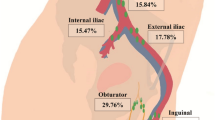Abstract
Purpose
To evaluate oncologic outcomes of early stage cervical cancer patients who underwent robotic radical hysterectomy (RRH) in a referral center, a retrospective analysis was performed.
Methods
From January 2010 to December 2018, medical records of stage IA2–IIA1 cervical cancer patients, who underwent radical hysterectomy at our institute, were retrospectively reviewed. We focused our analysis on those who underwent RRH.
Results
A total of 198 patients were included in the final analysis. Median follow up was 52 months. At last follow-up, 188 (94.9%) women were disease-free, 9 (4.5%) had died, and 1 (0.5%) was alive with recurrent disease. At 4.5 years, PFS was 93.1% (SE ± 2.1) and OS was 95.1% (SE ± 1.8). Stratified by tumor size, PFS for tumor < 2 cm versus tumor ≥ 2 cm was statistically different (96.8% ± 2.3 and 87.9% ± 4.1 respectively, p = 0.01), as well as OS (100% and 89.8% ± 40 respectively, p = 0.01).Stratified by evidence of tumor at time of robotic surgery, PFS was statistically different in women with no residual tumor after conisation versus those with residual disease (100% ± 2.5 and 90.8% ± 2.8 respectively, p = 0.04). A recurrence occurred in 11 patients (5.6%).
Conclusions
Based on our results, we could speculate that robotic approach, along with some technical precautions to avoid spillage, might be safe as primary treatment of early-stage cervical cancer, especially for tumor < 2 cm and in case of no evidence of disease at time of radical hysterectomy after previous conisation.



Similar content being viewed by others
References
Bray F, Ferlay J, Soerjomataram I, Siegel RL, Torre LA, Jema lA. Global cancer statistics 2018: GLOBOCAN estimates of cancer incidence and mortality for 36 cancers in 185 countries. CA Cancer J Clin. 2018;68:394–424.
American College of Obstetricians and Gynecologists. ACOG practice bulletin. Diagnosis and treatment of cervical carcinomas. Number 35, May 2002. American College of Obstetricians and Gynecologists. Int J Gynaecol Obstet. 2002;78(1):79–91.
Gaffney DK, Erickson-Wittmann BA, Jhingran A, et al. Appropriateness Criteria® on advanced cervical cancer expert panel on radiation oncology-gynecology. Int J Radiat Oncol Biol Phys. 2011;81(3):609–14.
Monk BJ, Tewari KS, Koh WJ. Multimodality therapy for locally advanced cervical carcinoma: state of the art and future directions. J Clin Oncol. 2007;25(20):2952–65.
Querleu D, Cibula D, Abu-Rustum NR. 2017 Update on the Querleu-Morrow Classification of Radical Hysterectomy. Ann Surg Oncol. 2017;24(11):3406–126.
Wang YZ, Deng L, Xu HC, Zhang Y, Liang ZQ. Laparoscopy versus laparotomy for the management of early stage cervical cancer. BMC Cancer. 2015;15:928.
Lee EJ, Kang H, Kim DH. A comparative study of laparoscopic radical hysterectomy with radical abdominal hysterectomy for early-stage cervical cancer: a long-term follow-up study. Eur J Obstet Gynecol Reprod Biol. 2011;156(1):83–6.
Nam JH, Park JY, Kim DY, Kim JH, Kim YM, Kim YT. Laparoscopic versus open radical hysterectomy in early-stage cervical cancer: long-term survival outcomes in a matched cohort study. Ann Oncol. 2012;23(4):903–11.
Sert BM, Boggess JF, Ahmad S, et al. Robot-assisted versus open radical hysterectomy: a multi-institutional experience for early-stage cervical cancer. Eur J Surg Oncol. 2016;42(4):513–22.
Ramirez PT, Frumovitz M, Pareja R, et al. Minimally invasive versus abdominal radical hysterectomy for cervical cancer. N Engl J Med. 2018;379(20):1895–904.
Querleu D, Morrow CP. Classification of radical hysterectomy. Gynecol Oncol. 2009;115(2):314–5.
Cibula D, Pötter R, Planchamp F, et al. The European Society of Gynaecological Oncology/European Society for Radiotherapy and Oncology/European Society of Pathology Guidelines for the Management of Patients with Cervical Cancer. Int J Gynecol Cancer. 2018;28(4):641–55.
Bhatla N, Berek J S, Cuello Fredes M, et al. Revised FIGO staging for carcinoma of the cervix uteri. Int J Gynecol Obstet. 2019;145:129–35.
Galaal K, Bryant A, Fisher AD, Al-Khaduri M, Kew F, Lopes AD. Laparoscopy versus laparotomy for the management of early stage endometrial cancer. Cochrane Database Syst Rev. 2012;(9) CD006655. PMID: 22972096
Walker JL, Piedmonte MR, Spirtos NM, et al. Recurrence and survival after random assignment to laparoscopy versus laparotomy for comprehensive surgical staging of uterine cancer: Gynecologic Oncology Group LAP2 study. J Clin Oncol. 2012;27(32):5331–6.
Jørgensen SL, Mogensen O, Wu CS, Korsholm M, Lund K, Jensen PT. Survival after a nationwide introduction of robotic surgery in women with early-stage endometrial cancer: a population-based prospective cohort study. Eur J Cancer. 2019;109:1–11.
Shah CA, Beck T, Liao JB, Giannakopoulos NV, Veljovich D, Paley P. Surgical and oncologic outcomes after robotic radical hysterectomy as compared to open radical hysterectomy in the treatment of early cervical cancer. J Gynecol Oncol. 2017;28(6):e82.
National Comprehensive Cancer Network (NCCN). Cervical Cancer Version 1. 2018; 2017.
Zhou J, Xiong BH, Ma L, Cheng Y, Huang W, Zhao L. Robotic vs. laparoscopic radical hysterectomy for cervical cancer: a meta-analysis. Int J Med Robot. 2016;12(1):145–54.
Pergialiotis V, Rodolakis A, Christakis D, Thomakos N, Vlachos G, Antsaklis A. Laparoscopically assisted vaginal radical hysterectomy: systematic review of the literature. J Minim Invasive Gynecol. 2013;20(6):745–53.
Shazly SAM, Murad MH, Dowdy SC, Gostout BS, Famuyide AO. Robotic radical hysterectomy in early stage cervical cancer: a systematic review and meta-analysis. Gynecol Oncol. 2015;138(2):457–71.
Frumovitz M, Dos Reis R, Sun CC, et al. Comparison of total laparoscopic and abdominal radical hysterectomy for patients with early-stage cervical cancer. Obstet Gynecol. 2007;110(1):96–102.
Cao T, Feng Y, Huang Q, Wan T, Liu J. Prognostic and safety roles in laparoscopic versus abdominal radical hysterectomy in cervical cancer: a meta-analysis. J Laparoendosc Adv Surg Tech. 2015;25(12):990–8.
Zhao Y, Hang B, Xiong GW, Zhang XW. Laparoscopic radical hysterectomy in early stage cervical cancer: a systematic review and meta-analysis. J Laparoendosc Adv Surg Tech. 2017;27(11):1132–44.
Diver E, Hinchcliff E, Gockley A, et al. Minimally invasive radical hysterectomy for cervical cancer is associated with reduced morbidity and similar survival outcomes compared with laparotomy. J Min Invasive Gynecol. 2017;24(3):402–6.
Diver E, Hinchcliff E, Gockley A, et al. Minimally invasive radical hysterectomy for cervical cancer is associated with reduced morbidity and similar survival outcomes compared with laparotomy. J Min Invasive Gynecol. https://doi.org/10.1016/j.jmig.2016.12.005. 2017;24(3):402–6.
Park DA, Yun JE, Kim SW, Lee SH. Surgical and clinical safety and effectiveness of robot-assisted laparoscopic hysterectomy compared to conventional laparoscopy and laparotomy for cervical cancer: a systematic review and meta-analysis. Eur J Surg Oncol. 2017;43(6):994–1002.
Zhang S sha, Ding T, Cui Z hui, Lv Y, Jiang R. Efficacy of robotic radical hysterectomy for cervical cancer compared with that of open and laparoscopic surgery: a separate meta-analysis of high-quality studies. Med (United States) Medicine. 2019;98:4.
Hoogendam JP, Verheijen RHM, Wegner I, Zweemer RP. Oncological outcome and long-term complications in robot-assisted radical surgery for early stage cervical cancer: an observational cohort study. BJOG An Int J Obstet Gynaecol. 2014;121(12):1538–45.
Malzoni M, Tinelli R, Cosentino F, Fusco A, Malzoni C. Total laparoscopic radical hysterectomy versus abdominal radical hysterectomy with lymphadenectomy in patients with early cervical cancer: our experience. Ann Surg Oncol. 2009;16(5):1316–23.
Soliman PT, Frumovitz M, Sun CC, et al. Radical hysterectomy: a comparison of surgical approaches after adoption of robotic surgery in gynecologic oncology. Gynecol Oncol. 2011;123(2):333–6.
Zanagnolo V, Minig L, Rollo D, et al. Clinical and oncologic outcomes of robotic versus abdominal radical hysterectomy for women with cervical cancer: experience at a referral cancer center. Int J Gynecol Cancer. 2016;26(3):568–74.
Zanagnolo V, Minig L, Cárdenas-Rebollo JM, et al. Robotic versus open radical hysterectomy in women with locally advanced cervical cancer after neoadjuvant chemotherapy: a single-institution experience of surgical and oncologic outcomes. J Minim Invasive Gynecol. 2016;23(6):909–16.
Obermair A, Gebski V, Frumovitz M, et al. A Phase III randomized clinical trial comparing laparoscopic or robotic radical hysterectomy with abdominal radical hysterectomy in patients with early stage cervical cancer. J Minim Invasive Gynecol. 2008;15(5):584–8.
Melamed A, Margul DJ, Chen L, et al. Survival after minimally invasive radical hysterectomy for early-stage cervical cancer. N Engl J Med. 379(20):1905–14.
Matsuo K, Machida H, Mandelbaum RS, Konishi I, Mikami M. Validation FIGO 2018 cervical cancer. Gynecol Oncol. 2019, 152 (1), 87–93
Ayhan A, Aslan K, Bulut AN, et al. Is the revised 2018 FIGO staging system for cervical cancer more prognostic than the 2009 FIGO staging system for women previously staged as IB disease? Eur J Obstet Gynecol Reprod Biol. 2019;240:209–14.
National Comprehensive Cancer Network, Cohen PA, Jhingran A, Oaknin A, Denny L. NCCN Clinical Practice Guidelines in Oncology. Cervical cancer. Lancet. 2019;393(10167):169–82.
Kim SI, Cho JH, Seol A, et al. Comparison of survival outcomes between minimally invasive surgery and conventional open surgery for radical hysterectomy as primary treatment in patients with stage IB1–IIA2 cervical cancer. Gynecol Oncol. 2019;153(1):3–12.
Uppal S, Rebecca Liu J, Kevin Reynolds R, Rice LW, Spencer RJ. Trends and comparative effectiveness of inpatient radical hysterectomy for cervical cancer in the United States (2012–2015). Gynecol Oncol. 2019;152(1):133–8.
Cusimano MC, Baxter NN, Gien LT, et al. Impact of surgical approach on oncologic outcomes in women undergoing radical hysterectomy for cervical cancer. Am J Obstet Gynecol. 2019;221(6):619.e1–619.e24.
Alfonzo E, Wallin E, Ekdahl L, et al. No survival difference between robotic and open radical hysterectomy for women with early-stage cervical cancer: results from a nationwide population-based cohort study. Eur J Cancer. 2019;116:169–77.
Falconer H, Palsdottir K, Stalberg K, et al. Robot-assisted approach to cervical cancer (RACC): an international multi-center, open-label randomized controlled trial. Int J Gynecol Cancer. 2019;29(6):1072–6.
Chiva L, Zanagnolo V, Kucukmetin A, et al. SUCCOR study. An international European cohort observational study comparing minimally invasive surgery versus open abdominal radical hysterectomy in patients with stage IB1 (FIGO 2009, < 4 cm) cervical cancer operated in 2013–2014. Int J Gynecol Cancer. 2019:29:A1–2.
Author information
Authors and Affiliations
Corresponding author
Ethics declarations
Disclosure
The authors deny any commercial interest that they may have in the subject of study and the source of any financial or material support.
Additional information
Publisher's Note
Springer Nature remains neutral with regard to jurisdictional claims in published maps and institutional affiliations.
Rights and permissions
About this article
Cite this article
Zanagnolo, V., Baroni, C., Achilarre, M.T. et al. Oncologic Outcomes of Robotic Radical Hysterectomy (RRH) for Patients with Early-Stage Cervical Cancer: Experience at a Referral Cancer Center. Ann Surg Oncol 28, 1819–1829 (2021). https://doi.org/10.1245/s10434-020-09016-1
Received:
Accepted:
Published:
Issue Date:
DOI: https://doi.org/10.1245/s10434-020-09016-1




